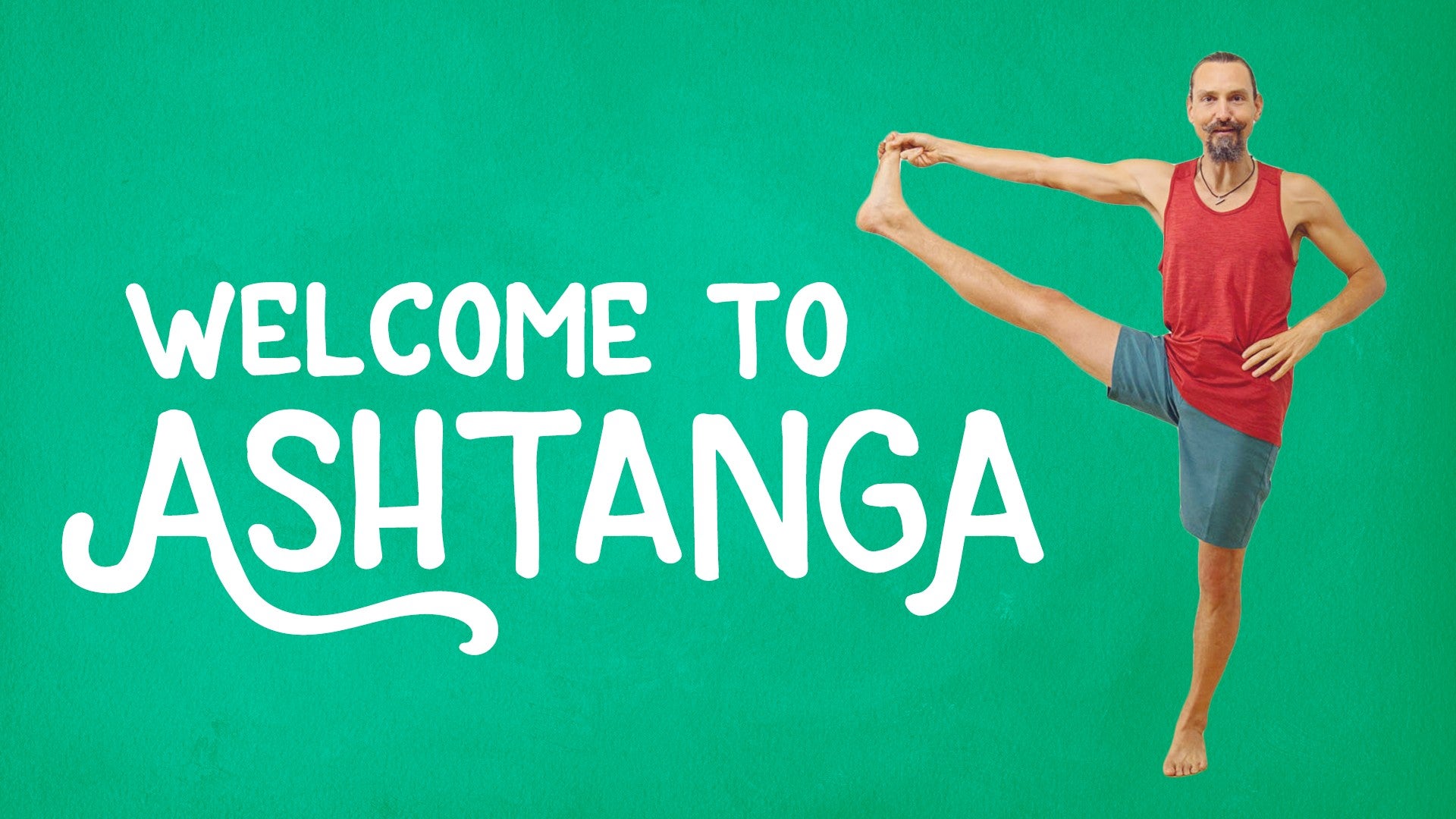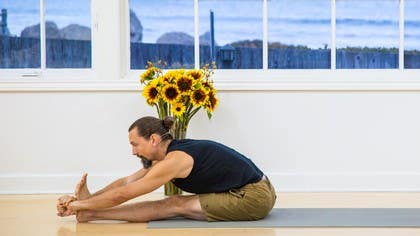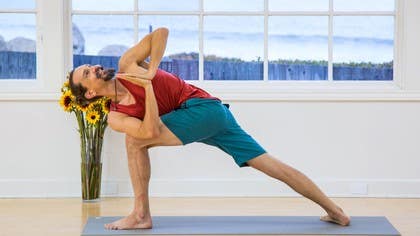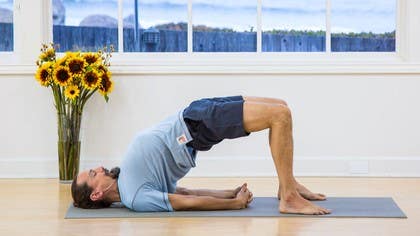Description
About This Video
Transcript
Read Full Transcript
Welcome to everyday backbends. This precious part of your daily practice should be able to lengthen your spine, expand your rib cage, give you more access to prana, energize you. It's going to be wonderful that you take on back bends as a daily practice. So ideally you've done some kind of standing or fundamental asanas, you've done a full practice already today. If you haven't, that's okay. You can jump right in here and we'll go through this series which is designed to give you access to your fullest expression of Urdhva Dhanurasana, the traditional backbend, by tangibly reminding your mind and body of the important priorities that occur throughout all backbends. Join me in samastitihi, standing at the top of your mat. Inhale, allowing the chest to rise, float the arms up, see your thumbs meeting together. Exhale, folding forward, finding the belly, diving to the spine, drop the head. Inhale, lift the head, lengthen the spine, looking forward. And exhale, step or jump the feet back, lowering to chaturanga, pausing there, take an inhale and then exhale and descend onto the mat, allowing your belly, your ribs, your pubic bones to touch the mat as you reach the arms in front of you and we'll get ready for sphinx. So sphinx position will be a great pose where you can take on great benefits of back bending while remaining completely safe and very passive in the entire length of the spine. The lower back will not back bend here, so you'll find that your pelvis is grounding on the mat and you'll also feel that your lowest ribs, the bottom of your rib cage, stays grounded. So you should be able to feel those points of pressure between the rib cage pushing down into the mat, as well as some aspect of the pelvis, perhaps the pubic bones pushing in the mat, and find that area between the rib cage and pubic bones, that home site of Udi and Abunda, feeling that it wants to lift the belly up to the spine. And as long as the lower back is absolutely comfortable and the rib cage stays grounding, you can start to walk the elbows back a little bit towards the shoulders. Now for some of us you may feel pinch in the lumbar spine, if that's the case bring your elbows further away and breathe comfortably, always finding Udi and Abunda. If it's comfortable though for you, you can bring the shoulders back further, the elbows back further, so that they come almost underneath the shoulders or you may be able to get the elbows underneath the shoulders themselves, still keeping the bottom of the rib cage on the mat. The lower back should be absolutely relaxed. If at some point you realize, oh my rib cage starts to float or my lumbar spine, my lower back feels pinching, feel free to put the elbows more forward, so that you can find a sustainable, comfortable, maintainable position here. Now the great benefit here is that our upper back may start to lengthen while the lumbar spine, the lower back staying neutral. Spread your fingers on the mat, draw your thumbs back deeply and in your comfortable position here roll the shoulders back and down, so you feel the center of the chest might move forward and almost feel as if you're pulling the elbows back towards the hips. Now the elbows won't move but as you continue that action, what may move is that your upper back may move forward. The space between the shoulder blades may lengthen forward, the front of the chest may move forward and breathe here, still maintaining that Uddiyana Bandha wants to draw the belly up to the spine, taking long deep full breaths here in your Sphinx position, just opening the upper back. Take a few more breaths here, shoulders back, chest forward and then exhaling you can come down, walking the hands forward and letting the head rest on one side or the other as you take a few breaths and then we'll flip it and do a different position, bring the hands back behind so the ten fingernails are grounding onto the mat. Spread your hands again so the thumbnails down, the pinky nails are down and we'll take Shalabhasana here, an active backbend that's going to help you strengthen all the muscles near the spine. Draw your feet together, heels are touching, big toes are touching if you can and then with your inhale lift your straight legs up off the mat. They may only come a little bit up off the mat, that's fine. Avoid the temptation to trick yourself by bending the knees and bringing the feet up higher, instead feel like you're lifting the back of the knee up off the mat and then with your next inhale roll the shoulders back, lift the chest, the chin stays parallel to the floor and you should be able to feel the muscles near the lumbar spine working. Take long full deep breaths here still pulling the chest forward, still finding Uddiyana Bandha, lifting to the spine and then you can bring the hands up off the mat, keeping the head lifted, keeping the feet lifted, bring the hands back by the hips, fingers spread, elbows around 90 degrees, so you're almost in Chaturanga position and then exhale, keeping the head lifted, put your feet flat on the floor, spread your ten toenails on the mat and with your inhale lift the chest forward and up to Upward-Facing Dog. Exhale to Downward-Facing Dog and here in Adho Mukha Svanasana, Downward-Facing Dog, take a few breaths. Inhale forward to a plank-like position, exhale into Chaturanga and inhale here if you can and then exhale come back down into the mat, keeping the hands just under the shoulders where they were in Chaturanga. Flatten your toenails on the mat, spread your toes apart from one another and try to feel your pinky toenail, your smallest toenail pushing into the mat, so here you might find that the thighs internally rotate to keep the pinkies pressing down. With strong legs exhale completely, find Uddiyana Bandha and inhale lift the chest slightly forward putting a very small amount of pressure in the hands. At first the lower rib cage stays down on the mat and you breathe here and if it's comfortable in the lower back you can put a little more pressure into the hands, lightly lifting the chest, keeping the shoulders rolled back and down, keeping the elbows pointing straight back behind you as you breathe in a baby bhujangasana and then exhale and come on down. So you're welcome to explore once more, one more time any of the three postures which we've just done, the baby bhujangasana, the baby cobra there, you could do the shalabasana again or the sphinx pose if you want to take that passive but still informative back bend or if the lumbar spine is feeling really good in all those postures you could take it all and apply it in upward facing dog. So it's your choice, do any repetition of one of the three from before or you could tuck the toes under and come with me as you inhale, lifting the body up off the mat, lifting the chest forward, inhaling the chest through the shoulders as you roll the shoulders down and if it's comfortable in the lumbar spine breathe here, still finding the pinky toenails pushing in the mat, strong legs straightening, udiyana bandha drawing the belly in and the center of the chest moving forward through the shoulders. Exhale and find downward-facing dog lifting the hips to the back corner of the room and take a few breaths here.
And now from downward dog we'll inhale and step or jump to a sitting position finding dandasana with the legs straight forward in front of you in your neutral pose of sitting. And simply lie down on your back with straight legs and the feet still on the floor, lie down on your back controlling the descent and we'll prepare for Urdhva dandarasana. So bend your knees and allow your feet to really ground on the mat, find that the feet are about the same distance away from the hips, it can be close, it can be far, it's up to you, but keep the heels wide, wider than your hips. You can use the fingers to cue that the heels are quite wide, make sure that the toes don't turn out to the side, the toes stay facing straight forward and you can spread the toes completely grounding through the root knuckle. Your big toe mound really wants to press down firmly onto the mat. The entire time you're doing Urdhva dandarasana keep trying to find your feet, tangibly feel the connection to the grounding through the root knuckle, big toe mound, also reminding you to ground internally every exhale a wonderful place to find the extra exhale engages the Bandhas at your core and your center. With your inhale simply lift the pelvis up off the floor so that's very slight, very little action as the hips lift and you breathe here. Now my lumbar spine, my lower back's imprinting on the mat, it's pushing down just my pelvis, just my hips are lifted and I can feel how strong that makes my udhyana bandha thus protecting the health of my lower back. Exhale completely keeping that strong core feeling, inhale and lift the tailbone towards the knees, lift the pelvis up, keep the hands down on the mat for now just next to the hips and roll the shoulders under more deeply. Still breathing here, can you find your big toe mound pushing down in the mat? Have your heels stayed wide? Are you still able to find udhyana bandha controls the action in the lumbar spine and are you able to bring the center of the chest more towards the head opening the area in between the shoulder blades? Even interlacing the fingers, rolling the shoulders under deeply, continuing with strong legs finding your feet, then exhale come down. Allow yourself to relax the position of the spine on the mat making sure that there's no tension residing in the lower back, you should feel good here. Now you're welcome to do two more modifications like that keeping the hands down by the side or if you're ready to start exploring Urdhva Dhanurasana bring the hands back behind the shoulders. Try to get the entire palm down on the mat, you may experiment with having hands closer to the shoulders or further away but find a space that works for you and just like you've connected to the feet, connect to the arms, spreading the fingers, spreading the toes, grounding through the root knuckles, exhale completely, lifting the pelvis, keeping the knees close, inhale trying to keep the elbows moving towards one another and lift, maybe you just come up onto your head, you could exhale there and inhale, lengthen through the arms lifting the pelvis up to the sky and breathe. Any time that you lose your breath just come down and regain the breath, any time that you feel some pinching in lower back come down and breathe. Otherwise feel that you can hold the back bend, lifting, internally rotating the thighs, keeping track of where the feet are, if you're super comfortable there you may be even walking the hands in ever so slightly, breathing and then exhale bending the knees, bending the elbows, lifting the chin up to the chest so that the shoulders come down first and then release the spine, the length of the spine on the mat and again find yourself relaxing in between backbends for now.
With time you'll be able to come from one Urdhva Dhanurasana down and then up and down and up but for now just check in make sure that everything feels good and smooth throughout the course of the spine and we'll do one more back bend together. Again you can always modify the hands down towards the feet or bringing the hands back behind the shoulders exhale here and prepare tipping the tailbone off of the mat, inhaling with a strong belly lifting up and breathe. Every exhalation is a wonderful chance for you to feel udhyana bandha trying to keep it strong through the inhalation as the chest gets flooded and expanded with breath. Take one more full deep breath here and exhale coming on down to the shoulders and we'll counter pose our backbends here. You could drive a knees in towards the chest, do a little rolling, a little massage for the lumbar spine, the lower back. You may roll forward and back side to side whatever feels right and in general go with the sensation if something doesn't feel right in this posture or the counter pose don't do it. With time the daily practice will open you up and warm you up to all sorts of different backbends. For now we're just exploring the priorities. Inhale and roll up to a seated position and we'll counter pose backbends right from here. You can straighten the legs in front of you. If the spine feels very comfortable, inhale reaching forward folding into Paschimantarasana. If the back feels like that's going to be tricky, if it feels a little creaky for now, experiment with crossing the legs and doing a forward bend here. This is going to make it very easy because the hamstrings won't pull on the pelvis. So you can exhale folding forward keeping length through the spine. You can catch some weight through the hands, suspending yourself there or if it's comfortable through the forearms and through the elbows. And breathe here either in the Paschimantarasana with straight legs or with crossed legs. Allowing yourself to counter pose those backbends in a deep forward fold. Still breathing deeply and letting go, feeling relaxed through the course of the spine. Inhale, come on up. And with your next exhalation find yourself in a comfortable cross-legged position. So you may be taking lotus or half lotus, whatever feels comfortable. From here exhale put the hands down into the mat and as you inhale try to lift the pelvis up. You can have the foot hanging off or if you're comfortable in lotus the foot may be rising up onto the thigh or you could be in simple crossed legs as well. Keeping the lift and exhale come down.
Really having fortified the core through the entire back bend practice. Find yourself in a comfortable sitting position. You can have the hands in any mudra. I have index finger and thumb lightly touching the other three fingers extending in chin mudra and the legs could be in any comfortable seated pose. Whatever feels good to you. A huge benefit of backbends is that you're strengthening and lengthening the upper spine. And so many times when you take on a sitting practice you may feel that the body starts to hunch and the upper back is weak. But with a dedicated daily back bending practice you're going to feel so much more openness in the front side of the body and so much more breath will be able to flow into the top of the chest. The tip of the tongue resting behind the upper teeth the jaw relaxed long full deep breathing with sound. You're welcome to stay seated here or if you want to lie down and take rest that's always a wonderful option after you've done a full dedicated practice and wonderful awareness through your back bending. Hopefully all these practices that we do help to build not only a physical asana practice but as well a meditative sequence that allows you to be able to find some comfort and stability in a sitting practice which should help you find comfort and stability in daily life. Blessings.
Welcome to Ashtanga
Comments
You need to be a subscriber to post a comment.
Please Log In or Create an Account to start your free trial.










